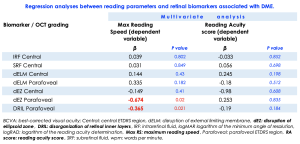Researchers at the Department of Ophthalmology, University of Turin, Italy, have reported a significant association between OCT biomarker measurements and reading performance in patients with DME. The research study found that the presence of disorganization of inner retinal layers (DRIL) in the parafoveal region had a significant impact on the reading performance. Radner reading charts were used to assess certain parameters, including reading acuity (RA) scores and mean reading speed (mean-RS) scores to measure the performance. Aside from the associations between biomarkers and reading performance, these measurements may additionally support the employment of evaluating a functional outcome measure in interventional clinical trials.
Diabetic macular edema (DME) is a common microvascular complication in the context of diabetic retinopathy, and the complication approximately affects 12% of patients with the disorder. The treatment of DME involves the use of intravitreal injections of pharmacologic agents including anti-vascular endothelial growth factor (VEGF) drugs and corticosteroids. In this prospective study, 35 patients were enrolled at the “Città della Salute e della Scienza” Hospital, University of Turin, 21 females and 14 males with a median (IQR) age was 74.0 (62.0–86.0 years) and 37 out of 49 eyes (75.5%) had evidence of DME. OCT images were graded for qualitative features the presence of intraretinal fluid (IRF) and/or subretinal fluid (SRF), structural alterations of the inner retina and outer retina including the ellipsoid zone (EZ) and external limiting membrane (ELM) bands assessed for their integrity, and structural alterations of the RPE. Reading performance, measured as maximum reading speed, was associated with specific retinal biomarkers. The disruption of the EZ in the parafoveal region and the presence of DRIL in the parafovea were correlated with reduced reading speed.
In brief, results of the multiple regression analysis showed a significant relationship between the max reading speed (dependent variable) and EZ disruption in the parafovea (p = 0.020) and the presence of DRIL in the parafovea (p = 0.021). Reading Acuity (RA) score (dependent variable) did not demonstrate any association with the variables examined:
Annotated and summarised in a table from a published paper entitled, “Retinal OCT biomarkers associated with reading performance in patients with persistent vs. resolved diabetic macular edema”, Ricardi et al., European Journal of Ophthalmology 2024, DOI: 10.1177/11206721241248682 journals.sagepub.com/home/ejo.
In their study, the Italian research team commented that, “Our study revealed a correlation between the integrity of the outer retinal layers and visual performance in previously treated DME patients. Notably, we identified EZ damage as a key biomarker for reading performance, as this was associated with a lower maximum reading speed. These results are intriguing when considering the metabolic function of the EZ, which contains the highest density of mitochondria. It is plausible that to achieve a higher reading speed with a high energy expenditure for the photoreceptor, the proper functionality of this layer is more crucial than that of the ELM, which primarily acts as an anatomical barrier toward the external retina.”

